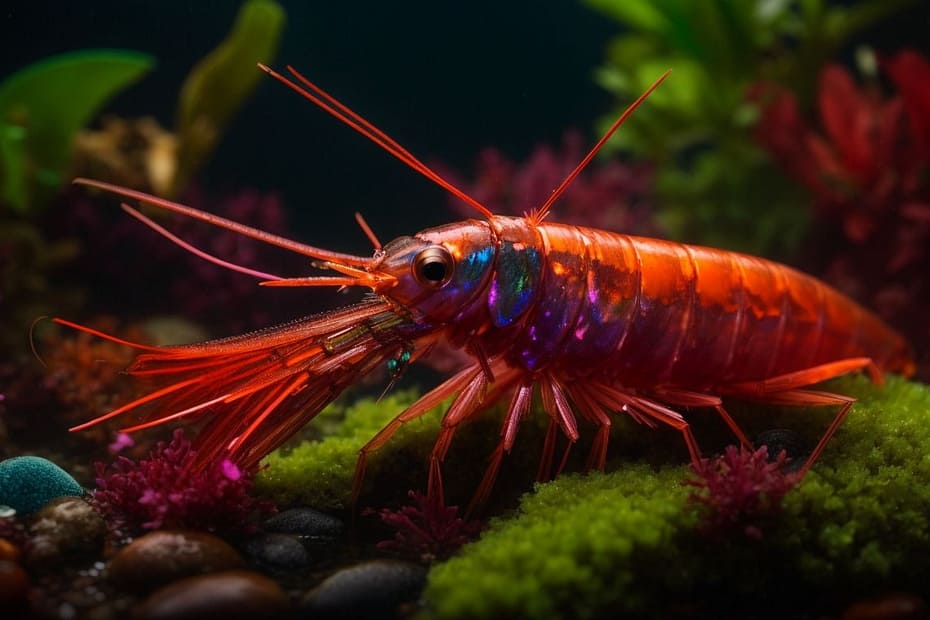Freshwater shrimp make exciting additions to any aquascape. With their bright colors and special behavior, they make a beautiful focus for your tank. No matter if you’re a beginner or an experienced aquarist, these colorful crustaceans offer lots of ways to create a mesmerizing underwater world.
You can find many different kinds of freshwater shrimp, from the flashy red Cherry Shrimp to the dazzling blue Blue Velvet Shrimp. They add depth and texture to your aquascape, giving you a vibrant and dynamic display.
Plus, freshwater shrimp are not just pretty. They are also useful cleaners! They eat up extra algae, keeping your tank healthy and clean. This is great for the water and all the other fish in there.
For your shrimp to stay happy and healthy, you need to give them what they need. They appreciate hiding spots like rocks or plants, and it’s important to have the right temperature and pH level.
Also, you need to look into whether their tankmates will eat them. Many fish will, so it’s best to have peaceful community fish like small tetras or rasboras as their friends.
Finally, when you welcome new shrimp to your aquarium, you should acclimate them. Slowly adjust them to the water conditions over time. This way, you can reduce shock and increase their chance of survival. It’s recommended to use the drip acclimation method, where water from the tank slowly drips into the container holding the new shrimp until there’s enough water volume.
What is Aquascaping?
Aquascaping is a creative art form that involves designing and creating visually stunning underwater landscapes in aquariums. It combines artistic aptitude with knowledge of aquatic species and fish behavior, resulting in mesmerizing aquatic displays.
- It includes carefully arranging plants, rocks, driftwood, and other decorative elements to craft natural-looking ecosystems for aquatic life.
- Lighting, water chemistry, and overall aesthetic all come into play.
- The aim is to recreate natural environments such as forests, mountains, or rivers within the confines of the tank.
- It brings together nature and design, generating a calming atmosphere in any living space.
Moreover, aquascapers continuously look for new ways to refine their designs. They explore unconventional materials such as mosses and ferns to create captivating textures and patterns. By adding vibrant colors and various aquatic creatures, they pursue creating spellbinding underwater realms.
Essentially, aquascaping requires patience and expert knowledge. It’s not just about putting plants together; it necessitates knowing their growth patterns, nutritional needs, and compatibility with other aquatic life. Dedicated aquascapers usually take time to maintain water quality by monitoring factors such as temperature and pH levels.
In collaboration with the Aquarium Co-Op team.
The Appeal of Colorful Freshwater Shrimp
Colorful freshwater shrimp are highly sought-after in aquascaping. Their vibrant hues and patterns make them a perfect addition to any aquarium or aquatic landscape. These tiny creatures have won the hearts of hobbyists and professionals alike.
- The main appeal of these shrimp is their striking colors. From fiery reds to electric blues and vibrant yellows, they bring a pop of life to any aquarium.
- Plus, they also have fascinating patterns – some have intricate stripes or spots, while others have bold, contrasting colors.
- But that’s not all; they are vital for maintaining the health and balance of aquatic ecosystems. They feed on algae and organic debris, cleaning the aquarium and preventing the growth of harmful substances.
- Moreover, many species of colorful freshwater shrimp possess unique characteristics or behaviors; some can even change color based on their mood or surroundings.
- Finally, they are relatively low-maintenance, making them suitable for both beginners and experienced aquarists.
The appeal of these shrimp lies in their colors, patterns, roles in aquarium ecosystems, unique characteristics, and ease of care. It is interesting to note that there are over 600 species of them known worldwide.
Popular Species of Colorful Freshwater Shrimp
Colorful freshwater shrimp are a must-have for aquascaping enthusiasts. Their vibrant colors and unique patterns make them a great addition to any aquarium. Whether you’re a beginner or an experienced hobbyist, there are plenty of species of colorful shrimp to choose from.
Here’s a table of popular species of colorful freshwater shrimp:
| Species | Scientific Name | Max Size | Coloration |
| Red Cherry Shrimp | Neocaridina davidi | 1 inch | Bright red |
| Blue Velvet Shrimp | Neocaridina cf. zhangjiajiensis | 1 inch | Deep blue |
| Crystal Red Shrimp | Caridina cantonensis | 1.5 inches | White and red |
| Yellow Longfin Shrimp | Caridina cf. babaulti var. “Yellow” | 2 inches | Yellow with long fins |
| Black King Kong Shrimp | Taiwan Bee Caridina cantonensis var. “Black” | 2 inches | Black with white stripes |
These are just a few examples. There are plenty more species out there. Each species has its own unique characteristics and care requirements, so make sure to research them before buying them.
Not only do they look amazing, but some species of colorful freshwater shrimp also have interesting behaviors and reproductive habits. For example, Red Cherry Shrimp reproduce quickly and are known for their ability to adapt to different water parameters.
If you want to add a pop of color and excitement to your aquascape, don’t miss out on these beautiful creatures. Explore different species and create an underwater paradise that will amaze everyone who sees it.
Care and Maintenance of Colorful Freshwater Shrimp
Vibrant freshwater shrimp can make an aquascape look captivating. Before you care for these colorful creatures, there are some points to remember:
- Give them the right water: Shrimp need stable conditions to thrive. The temperature should be between 22-26°C (72-78°F) and the pH level should be 6.5-8.0. Monitor these levels to keep them optimal.
- Make sure filtration is good: Effective filtration is essential for clean and healthy water. Get a filter that cleans out debris, chemicals, and bacteria.
- Feed them the right food: High-quality pellets or flakes formulated for shrimp and veggies like spinach or kale should make up their diet. Don’t overfeed them though, as it can harm water quality.
- Provide places to hide: Shrimp like to scavenge, so give them hiding spots like plants, caves, or driftwood. This will give the shrimp security while also making the tank look interesting.
- Minimize stress: Shrimp are sensitive and can be easily stressed by sudden changes. Keep the tank in a quiet spot and avoid fluctuations in temperature and lighting.
It’s important to research your particular species of shrimp. Different types may need different water parameters or have different dietary needs.
Fun Fact: Red Cherry Shrimp (Neocaridina davidi) is very popular due to its bright red color!
Tips for Creating a Stunning Aquascape with Colorful Freshwater Shrimp
Aquascaping with colorful freshwater shrimp? It can make any aquarium look amazing! Here’s how:
- Choose the right shrimp. Red Cherry Shrimp and Crystal Red Shrimp are popular for their dazzling colors. They also get along with other aquatic life.
- Create a lush environment. Add plants, rocks, and driftwood to make it look natural and give the shrimp hiding spots.
- Maintain water conditions. Make sure the pH, temperature, and hardness levels are right for the shrimp species. Good water quality means healthy shrimp.
- Provide adequate lighting. Use LED lights to show off the shrimp’s colors. But don’t overdo it, or you’ll stress them out.
- Choose tankmates wisely. Some fish might eat the shrimp. Research which fish are friendly before adding them.
Did you know some shrimp have “filter fans”? These nifty appendages sift through tiny particles, helping keep the water clean while looking cool.
Aquascaping has been around for thousands of years. Ancient Chinese texts mention ornamental shrimp. Now we combine art and science to make stunning underwater displays.
Potential Challenges and Troubleshooting
Maintaining a freshwater shrimp aquarium may be challenging. Here are some common issues and how to sort them out:
| Challenge | Troubleshooting |
| Water quality issues | Regular testing and maintenance. Proper filtration and oxygenation. |
| Aggression among shrimp | Provide hiding spots. Optimal tank size. Monitor behavior. |
| Diseases and parasites | Quarantine new shrimp. Good hygiene. Consider medication. |
| Incompatible tankmates | Research compatibility. Choose species with similar needs. |
More things to consider include: a balanced diet, decorations and substrate. The Aqua International Journal of Ichthyology states that some species of shrimp can change colors based on their mood or environment.
So, if you want to keep freshwater shrimp, be aware of potential issues and how to effectively address them.
Conclusion
Colorful freshwater shrimp make a great addition to any aquascape! Their vivid colors and behavior bring energy and beauty to the tank. Also, they are easy to look after and can do well in many water types.
The Red Cherry Shrimp and Blue Velvet Shrimp are renowned for their dazzling colors, making an eye-catching view in your aquascape. Not just for looks, they help keep the tank clean by getting rid of algae and other debris.
These freshwater shrimp are special because they can reproduce quickly. With proper care and the right environment, they will breed quickly, bringing even more color and activity to the tank! It’s super exciting to watch baby shrimp scuttling around.
Make sure to give your colorful freshwater shrimp plenty of places to hide. They love to escape into caves or dense plants like Java Moss or driftwood when feeling scared or while molting.
Top Tip: To keep your freshwater shrimp healthy, use a sponge filter instead of a regular filter that could suck them up due to their small size.
Frequently Asked Questions
What are the best colorful freshwater shrimp for aquascaping?
Some of the best colorful freshwater shrimp for aquascaping include Red Cherry Shrimp, Crystal Red Shrimp, Blue Diamond Shrimp, Orange Sakura Shrimp, Yellow Shrimp, and Amano Shrimp.
Can colorful freshwater shrimp be kept with other fish in the aquarium?
Yes, colorful freshwater shrimp can generally be kept with small, non-aggressive fish. However, it’s important to ensure the fish do not pose a threat to the shrimp, as some fish may eat or harm them.
How do I care for colorful freshwater shrimp in my aquascape?
To care for colorful freshwater shrimp, provide a well-maintained aquarium with plenty of hiding places, a suitable substrate, and a balanced diet. Regular water quality monitoring and adequate filtration are also essential for their well-being.
What should I feed colorful freshwater shrimp?
Colorful freshwater shrimp can be fed a variety of foods, including commercial shrimp pellets, algae wafers, blanched vegetables like zucchini or spinach, and even small amounts of high-quality fish flakes or pellets. It’s important to provide a diverse diet to ensure proper nutrition.
Can I breed colorful freshwater shrimp in my aquarium?
Yes, many colorful freshwater shrimp species can be bred in aquariums. Providing ideal water parameters, sufficient hiding places, and a proper diet can encourage breeding. Separate breeding tanks or shelters may be necessary to protect the offspring from other tank inhabitants.
How can I prevent diseases in colorful freshwater shrimp?
To prevent diseases in colorful freshwater shrimp, maintain good water quality, avoid overcrowding, and ensure a balanced diet. Quarantine new shrimp before introducing them to your main aquarium to prevent the spread of potential diseases. Regular observation and prompt action at the first sign of illness are crucial.

